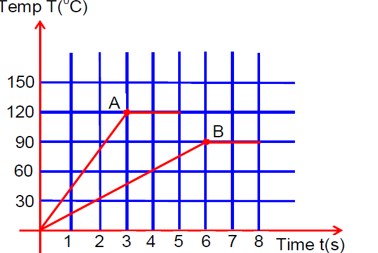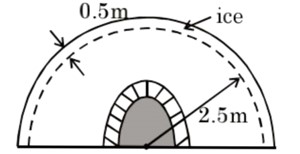Two different metal bodies A and B of equal mass are heated at a uniform rate under similar conditions. The variation of temperature of the bodies is graphically represented as shown in the figure. The ratio of specific heat capacities is :
(The graph shows Temperature (°C) on the y-axis and Time (s) on the x-axis. Both A and B are straight lines starting from the origin. For body A, temperature reaches 120°C in 4s. For body B, temperature reaches 90°C in 6s.)
Two different metal bodies A and B of equal mass are heated at a uniform rate under similar conditions. The variation of temperature of the bodies is graphically represented as shown in the figure. The ratio of specific heat capacities is :
(The graph shows Temperature (°C) on the y-axis and Time (s) on the x-axis. Both A and B are straight lines starting from the origin. For body A, temperature reaches 120°C in 4s. For body B, temperature reaches 90°C in 6s.)
Option 1 -
8/3
Option 2 -
3/8
Option 3 -
3/4
Option 4 -
4/3
-
1 Answer
-
Correct Option - 2
Detailed Solution:dQA = mACA dTA
dQB = mBCB dTB
dQA/dt = dQB/dt
⇒ mACA (dTA/dt) = mBCB (dTB/dt)
⇒ (dTA/dt)/ (dTB/dt) = (mBCB)/ (mACA)
Assuming mA = mB
(dTA/dt)/ (dTB/dt) = CB/CA
CA/CB = (dTB/dt)/ (dTA/dt) = (90/6)/ (120/3) = 15/40 = 3/8
Similar Questions for you
Thermal stress is developed on heating when expansion of rod is hindered.
According to question, we can write
400 × 1 × 12.5 = 500 × 5 × (100 – 36.5)
S = 10 cal/mol °C
Taking an Exam? Selecting a College?
Get authentic answers from experts, students and alumni that you won't find anywhere else
Sign Up on ShikshaOn Shiksha, get access to
- 65k Colleges
- 1.2k Exams
- 679k Reviews
- 1800k Answers


